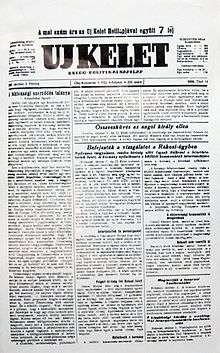Új Kelet
 | |
| Type |
weekly newspaper (1918-1920) daily newspaper (from 1920-2016) monthly newspaper (from 2016) |
|---|---|
| Editor | Eva Vadasz, Istvan J. Bedo, Anna Sebő, Sara Salamon, Kristof Steiner |
| Founded | 1918 |
| Language | Hungarian |
| Headquarters |
Transylvania (1918-1940) Tel Aviv (from 1948) |
| Country |
Romania (1918-1940) Israel (from 1948) |
| Website | https://ujkelet.com |
Új Kelet (Hungarian translation: "New East") is a Zionist Jewish newspaper in the Hungarian language published first in Kolozsvár (Cluj) in Transylvania, Romania, and reestablished after a 10 years break in Tel Aviv, Israel.
Upon the initiative of Chaim Weiszburg, a leader of the Zionist movement, Uj Kelet was launched as a weekly on December 19, 1918. It become a daily in 1920. The first editor was Béla Székely, who was succeeded in 1919 by Ernő Márton.
From 1927 until the end of its Transylvanian period, the editor was Ferenc Jámbor. After the Hungarian annexation of Cluj in 1940, the Horthy regime banned the paper because of its strong Zionist line. Márton emigrated to Palestine (Eretz Israel) after World War II, and in 1948, with David Schon the paper reappeared under his editorship in Tel Aviv. Among the known writers in the newspaper, in the period of his concert in Israel, there were Alexander Sauber, Rudolf Kastner, Yossef Lapid, Ephraim Kishon, Ottó Rappaport, Elemer Diamant, David Drori, Pal Benedek.
Új Kelet is the Independent Hungarian Language Israeli Paper as of January 2016 and is published on a monthly basis. Friends of Új Kelet.[1]
- Editor in Chief: Eva Vadasz
- Creative Art: Kristof Steiner
- Graphic Design: Julia Szasz, Sara Salamon, Lou Kiss
- Editors: Istvan J. Bedo, Anna Sebo
- Print: Hadfus Hechadash Ltd., Rishon Letzion
Contributors: Arje Singer, Avi ben Giora, Balázs Ibi, Borgula András, Egervári Vera, Frank Peti, Grünhut Éva, Halmos László, Halmos Sándor, Korányi Eszter, Krasznai Éva, Lévai György, Markovits Mária, Markovic Radmila, Dr. Paszternák András, Róna Éva, Schnapp Lea, Steiner Kristóf, Szabó Orsi, Surányi J. András
References
External links